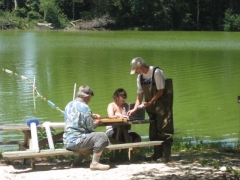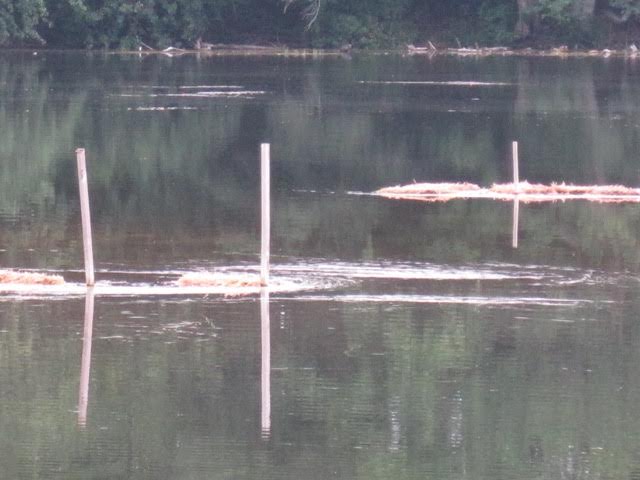Knauss legislative fellowships in Congress help build careers — and they're fun and educational. See our video and fact sheet for details.
How Understanding Culture Can Help Us Respond to Environmental Change
When I introduce myself as an environmental anthropologist, there’s often a pause followed by a look of confusion and then finally, “You’re a what?”
The most imaginative people key in on ‘anthropologist’ and assume I hang out with the likes of Indiana Jones. Alas, I don’t get to run around wearing a cool hat while narrowly escaping mummy attacks — if only my research was so exciting! But I do get to do some pretty cool work that builds knowledge about how people relate to the complex environmental changes we face in the Chesapeake Bay region today.
As an environmental anthropologist, I’m interested in how culture affects people’s relationship to the environment and informs their responses to environmental change. Culture is a powerful driver for all of us, giving us a set of shared values, beliefs, knowledge, and practices that shape how we experience the world, that tie us to particular communities and places, and inform our decision-making. But a challenge in understanding these cultural influences is that culture is so deeply ingrained that it’s difficult to recognize in ourselves, and often we don’t even notice that it’s there. And that’s where my work as an anthropologist begins.
Much of my research is guided by anthropology’s method of ethnography – the process of immersing oneself in the lives of others to try to understand what it’s like to walk in someone else’s shoes. Anthropologists often do this by spending time with the people they’re studying, observing their routines and practices, asking questions through casual conversations and in-depth interviews, and collecting data. This allows anthropologists to develop a big picture of how culture shapes attitudes, decisions, and behaviors. Ethnography also helps us understand how local-level actions are tied to broader political, economic, and social influences.
To give you an example from my own research, I’ve used ethnography to understand stakeholder responses to harmful algal blooms (HABs) in the Chesapeake Bay watershed. Blooms occur when algae proliferate to the point where it becomes harmful because it produces toxins or causes depletion of oxygen and sunlight needed to support underwater life. These events also pose human health risks and can severely impact communities that rely on affected waters to support livelihoods, tourism, and important social activities. HABs are increasingly problematic in our region due to warming waters and increasing nutrients that are food for algae.
From 2011 to 2013, I teamed up with researchers from the University of Maryland at College Park, the Institute of Marine and Environmental Technology, the Chesapeake Research Consortium, and the Maryland Department of Natural Resources to test new strategies to control toxic blue-green algal blooms (Microcystis aeruginosa) on Williston Lake, in Caroline County on Maryland’s Eastern Shore. One of our goals was to understand how different stakeholders at the local and regional level understood HABs and to identify key needs, interests, and concerns to consider in developing effective strategies for controlling HABs.
Through data gathered in stakeholder interviews and observations at community meetings, I identified several important factors. These included the cultural and economic importance of recreational use of the lake by a local Girl Scout camp and residents. There were also political concerns about the lake’s nutrients, particularly from county planners responsible for meeting EPA regulatory nutrient reductions and farmers who worried about being blamed for a century’s worth of nutrient accumulation in the lake. I also helped identify barriers to controlling HABs, such as opposing forms of knowledge about them (scientific versus local understandings), conflicting priorities, and past experiences and conflicts among the lake’s users. Understanding these barriers helped us to suggest how diverse concerns and interests could be accommodated and misunderstandings reduced when selecting and implementing HAB-control approaches at Williston Lake.
Projects to restore the Chesapeake Bay are important, but they’re most effective when they engage local communities in productive ways. Failure to understand the underlying cultural beliefs, values, priorities, and conflicts influencing stakeholder response may ultimately lead to failed implementation or restoration at the expense of community well-being. I’d go so far as to say that you can’t have one without the other. I hope that my research at Williston Lake gives you a taste for what environmental anthropology has to offer. Our ethnographic toolkit is useful well beyond algal blooms though, providing a way to better understand the range of social and cultural dynamics necessary for supporting Chesapeake Bay health. And I look forward to sharing more insights with you on its applicability in future blog posts about my upcoming dissertation research on climate change adaptation planning on the Deal Island Peninsula. Stay tuned!
Photo, top left: Scientists working at Williston Lake, where anthropological methods helped me identify important social and cultural drivers influencing how people understand and respond to harmful algal blooms. A toxic blue-green algal bloom caused the lake’s water to turn green, as shown here. Photo credit: Elizabeth Van Dolah
The following journal articles include more information about the research by my colleagues and me at Williston Lake:
E. Van Dolah, M. Paolisso, K. Sellner, and A. Place. “Employing a socio-ecological systems approach to engage harmful algal bloom stakeholders,” Aquatic Ecology, pp 1-18, first online December 11, 2015. DOI: 10.1007/s10452-015-9562-z
K. Sellner, A. Place, E. Williams, Y. Gao, E. Van Dolah, M. Paolisso, H. Bowers, and S. Roche. “Hydraulics and barley straw (Hordeum vulgare) as effective treatment options for a cyanotoxin-impacted lake,” A. Lincoln MacKenzie [Ed], Marine and Freshwater Harmful Algae 2014, Proceedings of the 16th International Conference on Harmful Algae, Cawthron Institute, Nelson, New Zealand and the International Society for the Study of Harmful Algae (ISSHA).
See all posts to the Fellowship Experiences blog




